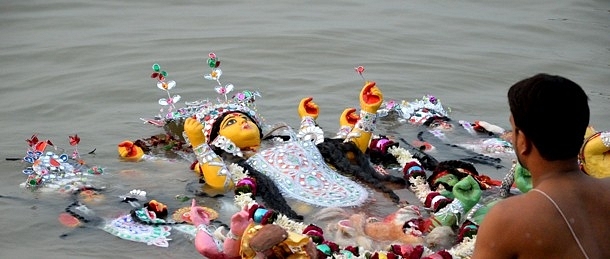
Mamata Banerjee Widening The Communal Divide In Bengal
Banerjee could have easily chalked out the routes for immersion and Muharram processions to ensure they do not overlap.
But by banning immersions she has laid herself bare once again to the charge of minority appeasement.
Bengal Chief Minister Mamata Banerjee frequently crows about the state being a haven of communal harmony where all religious communities co-exist in a climate of peace and tolerance. But this claim does not reflect ground realities.
While it is true that Bengal has not witnessed large-scale communal clashes like some other parts of the country, flawed, ill-conceived and petty policies aimed at appeasing some communities has resulted in a widening gulf between the Hindus and Muslims in Bengal. This is especially pronounced in rural areas where Muslims have a presence.
Hindus have, for quite some time now, been bristling against the undue favours showered on, and the blatant partisanship in favour of the minority community, by successive regimes in Bengal. And there is a history of bloody communal clashes prior to and during partition, the most gory among them being what is called the ‘week of the long knives’ in August 1946.
The sorry plight of Hindu refugees (on the eve of Partition and since then) from the other part of Bengal (erstwhile East Pakistan, now Bangladesh) brought about by the apathy of successive governments in the state towards them, and the contrasting molly-coddling of illegal Muslim migrants from Bangladesh, has fuelled a simmering anger among many Bengali Hindus. The result: growing polarisation among the two communities.
Banerjee knows these ground realities only too well. And that is why she has banned immersions of murtis of goddess Durga on 1 October, the day of Muharram. She fears clashes between the two communities, if Muharram processions and those taking the murtis of the Goddess for immersion, are allowed on the same day. That her fears are not unfounded have been proved periodically over the last few years when pockets in semi-urban and rural areas of the state have been wracked by communal clashes.
Ironically, by imposing this ban, Banerjee is admitting that all is not well between the two communities in Bengal. Had Bengal really been a showcase of communal harmony, there would have been no problem with two religious communities observing their rites on the same day. For arguments’ sake, if a Hindu religious event coincided with a Christian one, Banerjee would not have felt the need to impose restrictions on any.
But the bigger and more important point here is that Banerjee, by imposing restrictions like banning immersions on the day of Muharram, is only serving to widen the existing but narrow chasm between the two communities. As the Calcutta High Court rightly observed on Wednesday, such restrictions only divide the two communities. Acting Chief Justice Rakesh Tiwary tellingly observed that if the state government is claiming that complete communal harmony prevails in Bengal, then would such restrictions (banning immersion processions) not create a divide between the two communities.
Last year, too, the Banerjee government had drawn flak from the Calcutta High Court over banning immersions on the same grounds. Justice Dipankar Gupta had made scathing observations against the state government accusing it of “appeasing” minorities at the “cost of the majority” and turned down the ban.
The proper thing to do for Banerjee would have been to chalk out the routes for immersion and Muharram processions to ensure they do not overlap. She should also have imposed reasonable restrictions on both just as Yogi Adityanath government in Uttar Pradesh has done. Keeping the two processions away from each other is no difficult task for the police. After all, there will only be two Muharram processions in Kolkata and a similar number in all other towns across the state.
Had Banerjee only regulated the two processions to keep them away from each other and taken administrative and police measures to ensure communal harmony just as Adityanath has done, she would have appeared fair and even-handed. But by banning immersions on 1 October just for the sake of a couple of Muharram processions, she has laid herself bare once again to the charge of minority appeasement. And that will only fuel more communal polarisation in Bengal and widen the gulf between the Hindus and Muslims in the state.